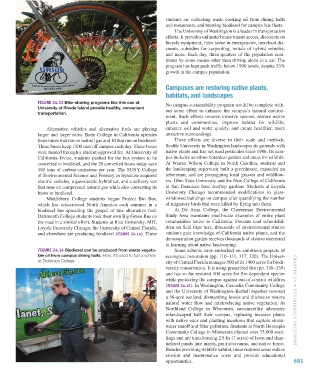Page 682 - Environment: The Science Behind the Stories
P. 682
students are collecting waste cooking oil from dining halls
and restaurants, and brewing biodiesel for campus bus fleets.
The University of Washington is a leader in transportation
efforts. It provides unlimited mass transit access, discounts on
bicycle equipment, rides home in emergencies, merchant dis-
counts, subsidies for carpooling, rentals of hybrid vehicles,
and more. Each day, three-quarters of the population com-
mutes by some means other than driving alone in a car. The
program has kept peak traffic below 1990 levels, despite 23%
growth in the campus population.
Campuses are restoring native plants,
habitats, and landscapes
Figure 24.13 Bike-sharing programs like this one at No campus sustainability program would be complete with-
University of Rhode Island provide healthy, convenient out some effort to enhance the campus’s natural environ-
transportation.
ment. Such efforts remove invasive species, restore native
plants and communities, improve habitat for wildlife,
Alternative vehicles and alternative fuels are playing enhance soil and water quality, and create healthier, more
larger and larger roles. Butte College in California operates attractive surroundings.
three buses that run on natural gas and 10 that run on biodiesel. These efforts are diverse in their scale and methods.
These buses keep 1100 cars off campus each day. These buses Seattle University in Washington landscapes its grounds with
were funded through a student-approved fee. At University of native plants and has not used pesticides since 1986. Its cam-
California–Irvine, students pushed for the bus system to be pus includes an ethno-botanical garden and areas for wildlife.
converted to biodiesel, and the 20 converted buses today save At Warren Wilson College in North Carolina, students and
480 tons of carbon emissions per year. The SUNY College the landscaping supervisor built a greenhouse, expanded an
of Environmental Science and Forestry in Syracuse acquired arboretum, and are propagating local grasses and wildflow-
electric vehicles, a gas-electric hybrid car, and a delivery van ers. Ohio State University and the New College of California
that runs on compressed natural gas while also converting its in San Francisco have rooftop gardens. Students at Loyola
buses to biodiesel. University Chicago recommended modifications to glass-
Middlebury College students began Project Bio Bus, windowed buildings on campus after quantifying the number
which has crisscrossed North America each summer in a of migratory birds that were killed by flying into them.
biodiesel bus spreading the gospel of this alternative fuel. At De Anza College, the Cheeseman Environmental
Dartmouth College students took their own Big Green Bus on Study Area maintains small-scale examples of entire plant
the road in a similar effort. Students at Rice University, MIT, communities native to California. Docents lead schoolchil-
Loyola University Chicago, the University of Central Florida, dren on field trips here, thousands of environmental studies
and elsewhere are producing biodiesel (Figure 24.14). These students gain knowledge of California native plants, and the
demonstration garden receives thousands of visitors interested
in learning about native landscaping.
Figure 24.14 Biodiesel can be produced from waste vegeta- Some schools have embarked on ambitious projects of
ble oil from campus dining halls. Here, it’s used to fuel a vehicle ecological restoration (pp. 110–111, 317, 320). The Univer-
at Dickinson College. sity of Central Florida manages 500 of its 1400 acres for biodi-
versity conservation. It is using prescribed fire (pp. 338–339)
and has so far restored 100 acres for fire-dependent species
while protecting the campus against out-of-control wildfires
(Figure 24.15). In Washington, Cascadia Community College
and the University of Washington–Bothell together restored
a 58-acre wetland, dismantling levees and ditches to restore
natural water flow and reintroducing native vegetation. At CHAPTER 24 • Su STA in A bl E Sol u T i on S
Northland College in Wisconsin, sustainability advocates
relandscaped half their campus, replacing invasive plants
with native ones and planting meadows that capture storm-
water runoff and filter pollution. Students at North Hennepin
Community College in Minnesota planted over 35,000 seed-
lings and are transforming 2.8 ha (7 acres) of lawn and chan-
nelized ponds into marsh, prairie/savanna, and native forest.
Besides providing wildlife habitat, these restored areas reduce
erosion and maintenance costs and provide educational
opportunities. 681
M24_WITH7428_05_SE_C24.indd 681 13/12/14 10:40 AM

